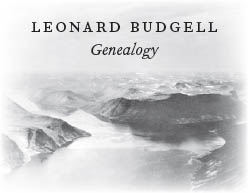

Len Budgell’s family traces its roots in Newfoundland back to the latter part of the eighteenth century. In the 1700s, when fishing companies recruited fishermen from England and Ireland for the Newfoundland fisheries, either Len’s grandfather, John Budgell, or his great-grandfather had come to Newfoundland. There is a record of a Joseph Budgell with the Slade Company from 1790 to 1792 at Fogo Island. The Slade’s employees usually stayed for three years before returning to England. These Budgells were from Dorset, and the Slade Company owners, originally from Dorset, had been recruiting from that area for a hundred years. As time went on, more of the Slade’s servants began staying on in Newfoundland and bringing their families to the colony rather than returning to England. By 1850 almost all employees were recruited locally from those who stayed.
In an oral history taken by Jocelyn McKillop for The Hudson’s Bay Company Archives in 1982, Len says that two Budgell families originally came and stayed in the area. Some settled around Point Leamington. In the 1836 census for Shoe Cove, there appeared an Elias Budgel, then over sixty, and a Giles Budgel, under fourteen. The same year, at Flurry’s Bight, a John Budgell was recorded in Twillingate District, as well as a Joseph Budgell, over sixty years of age. These may have been the Budgells in the Slade reports from forty-five years earlier. Many Budgells are also recorded in the Exploits Valley of central Newfoundland at that time. Whichever branch he was from, John Budgell was fishing from Fogo Island when he married for the first time in 1866.
John wed Rebecca Harnett and the couple had seven or eight children while at Island Harbour on the west side of Fogo. There is no record for the death of Rebecca, but Len’s family knew that their father had older half-brothers and half-sisters from an earlier marriage. When he subsequently married Emma Jane Foote in 1885, John Budgell settled on the other side of Fogo Island at Wild Cove, near Seldom Come By. John was listed as a fisherman on the wedding certificate. Both John and Emma Jane signed with an “X.”
Their third child, George, was born in 1887. Four years later, John died in 1891. No specific record for Emma Jane’s death has been found, but the unidentified “Budgell” death recorded on a page titled “1891 or ’92” may have been that of George’s mother.
Young George was the last of many children from the two marriages, and upon his parents’ deaths, he and one of his sisters were sent to stay at White Bay, near Hampden, in Newfoundland, where Parson Charles Woods of the Church of England undertook the care and education of orphans. This development was the break from tradition that would mean George, unlike his father and brothers, would not become a fisherman, but a schoolteacher. George completed Grade 9 in 1903. For further successful studies, he was awarded the Victory Medalet in 1905, a special medal made of copper from Admiral Nelson’s ship, the Victory, which was sent to every part of the British Empire to commemorate the Nelson centennial.
Some time after 1910, George was given charge of teaching in Labrador. This was an itinerant position in the Cartwright area, which meant spending roughly three months in one place, then travelling on to the next group of homes. In the winter, it sometimes meant walking on snowshoes for up to a hundred kilometres as he could not afford to own a dog team.
A few years later, George Budgell was sent to be the teacher/catechist responsible for the area around Hamilton Inlet. At Dove Brook, he met Phyllis Painter and married her on October 4, 1914. Phyllis Painter was born in Dove Brook to Mary Brown, daughter of William Brown of England and Marth Smith of Carbonear, Newfoundland. Silas Painter, born in Dove Brook, was the child of George Painter of England and Margaret Brown of Petty Harbour, Labrador. Margaret had been married to Richard Bird.
George Budgell and Phyllis would have ten children; one child died at the age of four months and is buried at Davis Inlet. In 1915, when he was twenty-eight years old, George was hired by The Hudson’s Bay Company to serve at Rigolet as clerk and postmaster. Leonard Gordon Budgell was the couple’s second child, their second son.
Len wrote of Labrador and his yearning to return there in nearly every letter he wrote in the last years of his life. His family travelled to North West River to leave Len’s ashes by his parents’ graves.